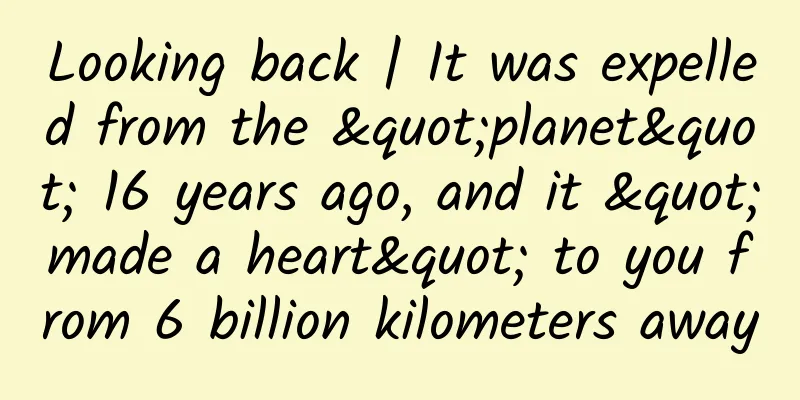Looking back | It was expelled from the "planet" 16 years ago, and it "made a heart" to you from 6 billion kilometers away

|
16 years ago, August 24, 2006, was destined to go down in the history of astronomy. Pluto, which had been listed as one of the nine planets since its discovery in 1930, had long been questioned because of its many differences from the other eight planets. Finally, at the 26th International Astronomical Union (IAU), it was downgraded from the ninth planet in the solar system to a dwarf planet and renamed "Asteroid 134340". Why was Pluto demoted? The existence of Pluto was first proposed in the early 20th century by Percival Lowell, who calculated that the wobble of the orbits of Uranus and Neptune was caused by the gravity of an unknown ninth planet. Ten years later, on March 13, 1930, astronomer Clyde Tombaugh confirmed the existence of Pluto at Lowell Observatory. Clyde Tombaugh, discoverer of Pluto Since then, Pluto held the title of ninth planet in the solar system until 2003, when astronomers discovered 2003-UB313, also known as Eris, which is almost as large as Pluto but much more massive. The discovery of Eris sparked a heated debate in the astronomical community. If Pluto is a planet, then Eris should be one too. So on August 24, 2006, the 26th International Astronomical Congress held in Prague, the capital of the Czech Republic, confirmed the name and definition of a planet. A "planet" refers to a celestial body that orbits the sun, has enough gravity to overcome its rigid body force and make the celestial body spherical, and can clear other objects near its orbit. If a celestial body that is not a satellite only meets the first two criteria, it will be classified as a "dwarf planet." The IAU believes that the necessary conditions for a planet to be formed are: 1. Have an orbit around the sun; 2. Have enough mass to maintain hydrostatic equilibrium (due to being pressed into a spherical shape by gravity); 3. It is the dominant celestial body in its orbit. Eventually, after the International Astronomical Union (IAU) released new criteria for planets, both Pluto and Eris were classified as dwarf planets. The IAU finally ruled that Pluto was no longer a planet because Pluto's orbit overlapped with Neptune's. In addition to Pluto and Eris, there are three known dwarf planets in the solar system: Ceres in the asteroid belt between Mars and Jupiter, Haumea beyond the orbit of Neptune, and Makemake in the Kuiper belt. Pluto becomes the representative of dwarf planets Pluto is located in the Kuiper Belt of the solar system, about 6 billion kilometers from the Earth. It is mainly composed of rocks and ice, which is also one of the characteristics of Kuiper Belt objects. When Pluto was still the ninth planet, it was the smallest of the nine planets, but when it retreated back to the ranks of dwarf planets, it became the largest and second most massive dwarf planet in the solar system. Size comparison of Pluto, its moon Charon, and Earth How should we describe the size and mass of Pluto? Let's compare it with the moon we are familiar with. Its mass is only 1/6 of the moon's, and its volume is only 1/3 of the moon's. However, Pluto's appearance looks much more gorgeous than the moon. There are three colors on Pluto's surface: charcoal black, light orange and white. The surface of Pluto is mainly composed of solid nitrogen, accounting for more than 98%, and the rest is trace amounts of methane and carbon monoxide. The distribution of these substances on Pluto is also different. The side facing Charon contains more methane, while the side facing away from Charon contains more carbon monoxide and nitrogen. Because the rocks inside Pluto and the ice on its surface will separate under the heat of radioactive element decay, scientists believe that Pluto's internal structure has undergone a stratified change: the core is composed of rock, and the mantle surrounding the core is composed of ice. There may also be a layer of liquid water between the core and the mantle. It has a romantic "little heart" On January 19, 2006, NASA's New Horizons probe was successfully launched, carrying the infinite hope of human exploration of the unknown and the ashes of Tombaugh, the discoverer of Pluto. The New Horizons probe carries seven instruments, including a visible-infrared imaging spectrometer, a remote survey imager, a solar wind analyzer, an ultraviolet imaging spectrometer, a high-energy particle spectrometer, a radio science device, and a dust counter, to study the composition and temperature of Pluto's atmosphere and surface materials. New Horizons probe On July 14, 2015, the New Horizons probe took the first close-up photo of this distant and mysterious planet at a distance of 12,550 kilometers from Pluto. The photos became an instant hit as soon as they were released. The incredibly diverse and complex terrain of this cold dwarf planet has astonished imaginative researchers and space fans. There is a huge heart-shaped bright area on Pluto, which adds a touch of romance to Pluto. Pluto with a huge "heart shape" In this huge heart shape, nitrogen glaciers slowly flow into the depths of the cold basin. To the west of the nitrogen glaciers, there is a plateau called "Sputnik". Although it is a plateau, it is not prominent because it is located in the basin. There are many craters on the surface of Pluto, but this "heart-shaped" area can "stay out of the mud without being stained" and still maintain a smooth surface. And it seems that some mysterious force has healed its surface. What is going on? Perhaps the key reason lies in the strange material that formed this plateau. Nitrogen is the most abundant component in Pluto's atmosphere, but the extremely low temperature condenses nitrogen into nitrogen ice and falls on the surface of Pluto. The surface of these nitrogen ices on Sputnik Planitia is covered with honeycomb patterns. Honeycomb pattern Could it be that these strange patterns erased the craters that should have existed? Scientists estimate that the weak heat flow inside Pluto drives the warm nitrogen ice upward, just like the convection phenomenon of liquid, the high-temperature liquid rises from the bottom and the low-temperature liquid sinks from the surface, gradually forming a piece by piece honeycomb pattern. The nitrogen ice in Pluto's atmosphere condensed in the form of nitrogen frost in the lowest part of the crater, gradually filling the depression and "self-healing" to become the heart-shaped honeycomb plateau we see today. The heart-shaped area on Pluto was later named after Clyde Tombaugh, the scientist who discovered Pluto, and is called the "Tombaugh Reservoir". After Clyde Tombaugh's death, his family put some of his ashes into an aluminum can. As the "New Horizons" probe flew towards Pluto, Tombaugh, who had never really seen Pluto clearly in his life, became the closest human to it. There are still many questions and mysteries about Pluto, and perhaps all of this will only be revealed one by one when science advances again or when humans are able to set foot on Pluto. Comprehensive compilation: CCTV Science and Education, "Haohan Universe" WeChat public account, Science and Technology Daily |
<<: Are adolescent kids really here for “revenge”?
>>: Chongqing finally welcomes artificial rainfall! Experts: This cloud has been "audited"
Recommend
What are the pros and cons of wind power construction? Why is China stepping up its construction efforts?
As the global greenhouse effect becomes more seri...
User Growth: Why isn’t your user base growing?
The changes of the times and channels will bring ...
Editor-in-Chief Liu's 21-lesson writing practice training camp is worth 2,299 yuan
Understanding market demand with Editor-in-Chief ...
Get the LaunchImage of the app
[[153741]] The management of LaunchImage is actua...
How much does it cost to customize an animation mini program in Chizhou?
The mini program provides convenience for publici...
Want a “screen-sweeping” promotion for NetEase Music? Here are 8 ways
Why does the traffic increase when users are mock...
Google's return to China: Who is optimistic, who is pessimistic, who is panicking, and who is looking forward to it?
In February 2016, Google will officially return t...
Product Manager Knowledge System - Product Operation
The five elements in the product manager's kn...
6 ways to promote your app and attract new users. Do you know how to use them all?
Since the development of China's Internet, in...
Detailed official interpretation of TikTok operations, policies, etc.!
After TikTok became popular, a large number of so...
Three ways to get traffic
Look at the picture I posted below. This is a pic...
Why has Tik Tok become a great tool for promoting products?
Why is Tik Tok so magical in promoting products? ...
Luo Xiaobu: Broadcasting and TV operators who block IPTV/OTT are hopeless
On March 3, Luo Xiaobu, deputy general manager of...
Register and upload an app market account in three steps!
Let me introduce myself first. I am a newbie in a...
Douyin private domain solution and four core capabilities
01 Positioning and value of Douyin private domain...









